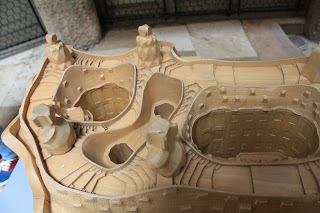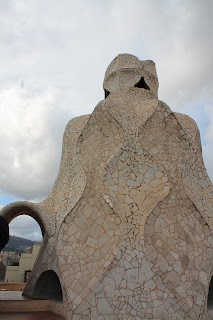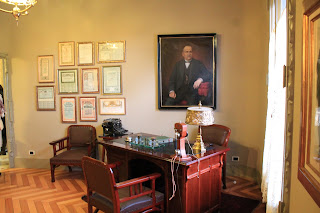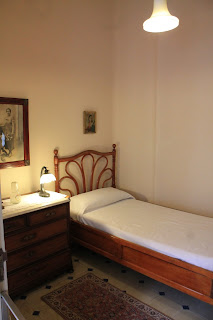Den Namen La Pedrera, der Steinbruch, verdankt das Haus seiner Fasade aus unbehauenen Steinen, und wunderschön im Kontrast die schmiedeeisernen Balkone, improvisiert von Josep Maria Jujol, die aussehen, wie Tang, der an den Strand gespült wurde.
Der Grundriß folgt keiner geometrischen Form, es gibt zwei Innenhöfe und das Haus schlängelt sich wie eine Acht um sie herum, die Fassade ist selbsttragend und auch hier gibt es wieder keine rechten Winkel im Gebäude. Gaudí war auch hier wieder Baumeister, Innenarchitekt und Dekorateur.
Die Familie Milà bewohnte die Belle Etage, die Wohnungen in den anderen 5 Etagen wurden vermietet. Die Geschichte des Hauses ist wechselhaft, während der Franco-Ära musste Pere Milà fliehen und nahm nur wenige Kunstgegenstände mit. Gaudis Möbel verschwanden und wurden durch andere, vermeintlich schickere ersetzt, als Milà im Jahr 1940 starb, wurde das Haus von seiner Witwe verkauft und umgebaut. Als diese im Jahr 1964 das Zeitliche segnete, wurden weitere Umbauten und Anpassungen an die Bedürfnisse der Zeit vorgenommen. Ende der 60er Jahre wurde Gaudìs Genie erkannt, aber erst 1984 wurde die Casa Milà zum Weltkulturerbe erklärt
The name La Pedrera got the building from it's facade, made of fieldstone, and very beautiful as a contrast the balconies made of wrought iron in the shape of sea weed washed to the shore.
The groundplan is not following any geometrical pattern, there are two yards and the building winds up around them like a Eight. The facade is selfcontained, and again the is no right angle in the whole house. Gaudi was builder, architect and decorator in one person.
The Milà family lived in the Belle Etage, die apartments in the other five floores were rented. The history of the house is erratic. During the Franco era Pere Milà fled and took only some artwork with him. Gaudi's interior vanished and was replaced by something more fancy. Milà died in 1940 and the properly was sold by his widow and was under construction than. She passed away in 1964 and the construction went on and a many rooms were changed due the needings of the time. End of the 60s the genius of Gaudi was recognised by the public and in 1984 it become world cultural heritage.
This was the last secular building Gaudi did, after that he only worked at the Sagrada Familia until he died ( http://fraumb-far-far-away.blogspot.de/2013/03/heiligkeit-in-stein-gemeielt-sagrada.html ).






























































Keine Kommentare:
Kommentar veröffentlichen